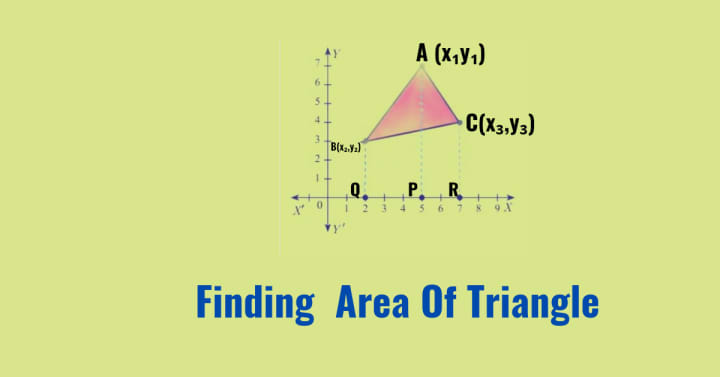Formula Of Area Of Triangle In Coordinate Geometry
Area of triangle

Introduction:-
Today I have come infront of you with an very essential topic of geometry,how to find the formula of area of triangle in coordinate geometry,which is vital for solving various mathematical problems involving triangles. This formula helps us to calculate the area of a triangle based on the coordinates of its vertices. Understanding this formula is very important for geometry students and can be applied in large number of real-life applications, such as finding the area of a piece of land or determining the area of a triangle-shaped object.
Explanation:-
To understand how to find the formula of area of triangle in coordinate geometry, let us first we will examine the concept of coordinates. In coordinate geometry, a point in a cartesian space is represented by an ordered pair (x, y). The x-coordinate represents the point's position on the horizontal axis,which is called abscissa while the y-coordinate represents its position on the vertical axis,which is called ordinate. By using these coordinates, we can determine the lengths of the triangle's sides and ultimately we can find its area.
Now, let's consider a triangle with vertices A(x₁, y₁), B(x₂, y₂), and C(x₃, y₃). To find the area of this triangle, we can use a formula known as the "shoelace formula" or the "coordinate area formula." The shoelace formula is derived from the fact that the area of a triangle can be represented as half of the absolute value of the determinant of the coordinates of its vertices.

The formula to find the area of a triangle in coordinate geometry is given as follows:
Area = ½ × |(x₁y₂ + x₂y₃ + x₃y₁) - (x₂y₁ + x₃y₂ + x₁y₃)|
Let's break down the steps involved in using this formula. First, we will multiply the x-coordinate of the first vertex by the y-coordinate of the second vertex, the x-coordinate of the second vertex by the y-coordinate of the third vertex, and the x-coordinate of the third vertex by the y-coordinate of the first vertex. We will then add these products together.
Next, we will multiply the x-coordinate of the second vertex by the y-coordinate of the first vertex, the x-coordinate of the third vertex by the y-coordinate of the second vertex, and the x-coordinate of the first vertex by the y-coordinate of the third vertex. Then,we will add these products together.
Lastly, we will subtract the second sum from the first sum and will take the absolute value, and will divide the result by 2.
Let's work through an example to illustrate the application of this formula. Consider a triangle with vertices A(1, 2), B(4, 3), and C(6, 7). We can use the formula mentioned earlier to find the area of this triangle.
Area = ½ × |(1×3 + 4×7 + 6×2) - (4×2 + 6×3 + 1×7)|
= ½ × |(3+28+12) - (8+18+7)|
= ½ × | 43 - 33|
= ½ × 10
= 5 square units
After performing the calculations, we find that the area of this triangle is 5 square units. This provides us with valuable information about the triangle's size and allows us to compare it with other geometric shapes.
Some Problems based Area Of Triangle:-
Question(1): Three sides of a triangle are (5,3),(7,4) and (6,1) Find the area of the triangle.
Solution:-
1st Method:-
Here,
x₁ = 5, x₂ = 7, x₃ = 6
y₁ = 3, y₂ = 4, y₃ = 1
∴ Area of the triangle = ½ × |(x₁y₂ + x₂y₃ + x₃y₁) - (x₂y₁ + x₃y₂ + x₁y₃)|
= ½ × | (5 × 4 + 7 × 1 + 6 × 3) - (7 × 3 + 6 × 4 + 5 × 1)|
= ½ × | (20 + 7 + 18 ) - ( 21 + 24 + 5)|
= ½ × | 45 - 50 |
= ½ × | ( -5 ) |
= ½ × 5
= 2.5 square unit.
2nd Method:-
Here,
x₁ = 5, x₂ = 7, x₃ = 6
y₁ = 3, y₂ = 4, y₃ = 1
∴ Area of the triangle = ½ × | x₁( y₂- y₃) + x₂ (y₃ - y₁) + x₃ (y₁ - y₂)|
= ½ × | 5 (4 - 1) + 7 (1 - 3) + 6 ( 3 - 4 )|
= ½ × | 5 × 3 + 7 ( - 2 ) + 6 ( -1 )|
= ½ × | 15 - 14 - 6 |
= ½ × | 15 - 20 |
= ½ × | - 5 |
= ½ × 5
= 2.5 square unit.
Question(2): If three sides of triangle ABC, are A(2,3), B (4,1) and C (5,6), Find the area of the triangle.

Solution:-
1st Method:-
Here,
x₁ = 2, x₂ = 4, x₃ = 5
y₁ = 3, y₂ = 1, y₃ = 6
∴ Area of the triangle = ½ × |(x₁y₂ + x₂y₃ + x₃y₁) - (x₂y₁ + x₃y₂ + x₁y₃)|
= ½ × | (2 × 1 + 4 × 6 + 5 × 3) - (4 × 3 + 5 × 1 + 2 × 6 ) |
= ½ × | (2 + 24 + 15) - (12 + 5 + 12) |
= ½ × | ( 41 - 29)|
= ½ × | 12 |
= ½ × 12
= 6 square unit.
2nd Method:-
Here,
x₁ = 2, x₂ = 4, x₃ = 5
y₁ = 3, y₂ = 1, y₃ = 6
∴ Area of the triangle = ½ × | x₁( y₂- y₃) + x₂ (y₃ - y₁) + x₃ (y₁ - y₂)|
= ½ × | 2 (1 - 6) + 4 (6 - 3) + 5 (3 - 1)|
=½ × | 2 ( -5 ) + 4 ( 3 ) + 5 ( 2 )|
=½ ×| - 10 + 12 + 10 |
= ½ × | 12 |
= ½ × 12
= 6 square unit
The formula for finding the area of a triangle in coordinate geometry is a powerful tool that can be applied to various scenarios. Whether you're studying geometry or dealing with real-life applications, understanding this formula is crucial for accurate calculations.
Furthermore, this formula can be extended to find the area of any polygon in coordinate geometry. By identifying the coordinates of its vertices, one can follow a similar process to calculate the area of polygons with numerous sides.
Conclusion:-
In conclusion, how to find the formula of area of triangle in coordinate geometry plays a significant role in solving problems related to triangles in mathematics specially in geometry and real-life applications. By using the coordinates of the triangle's





Comments
There are no comments for this story
Be the first to respond and start the conversation.